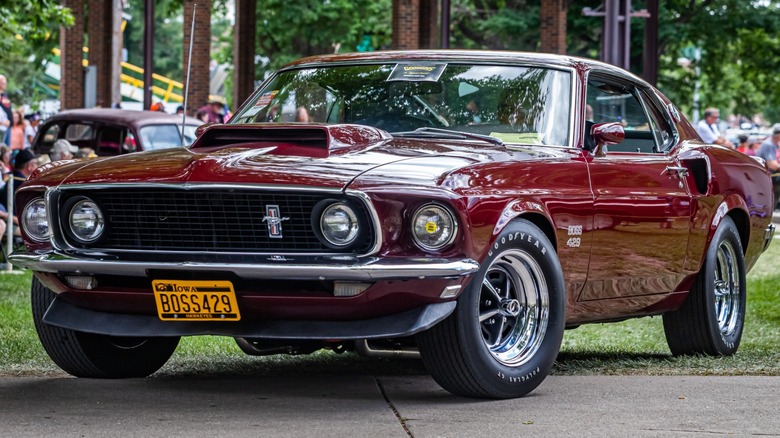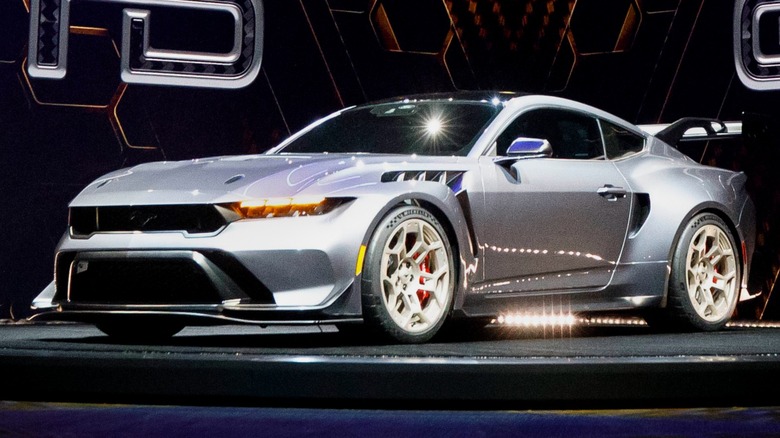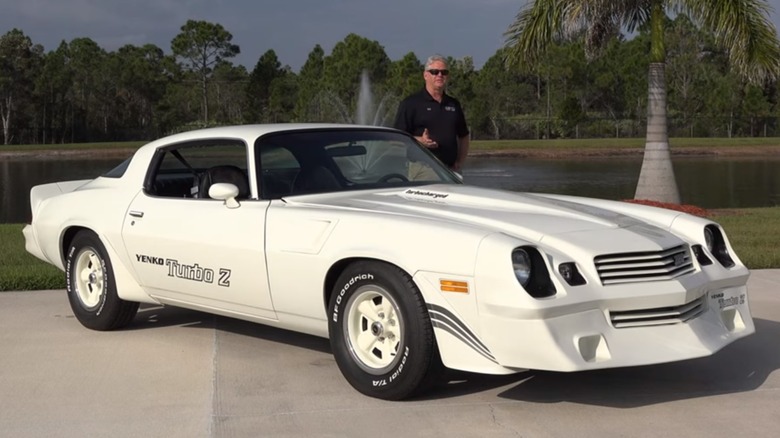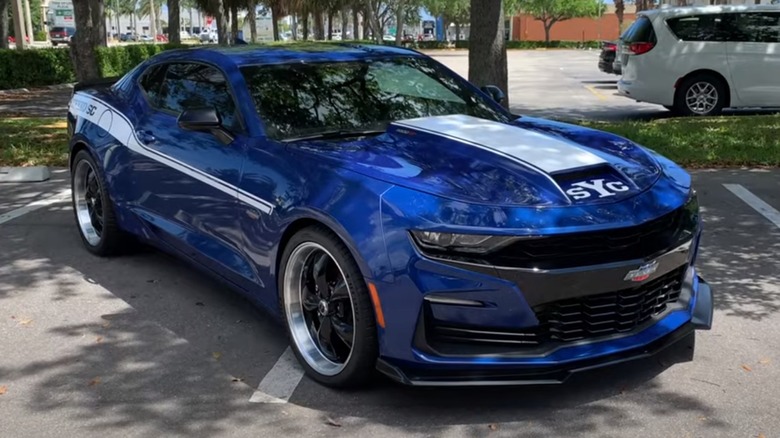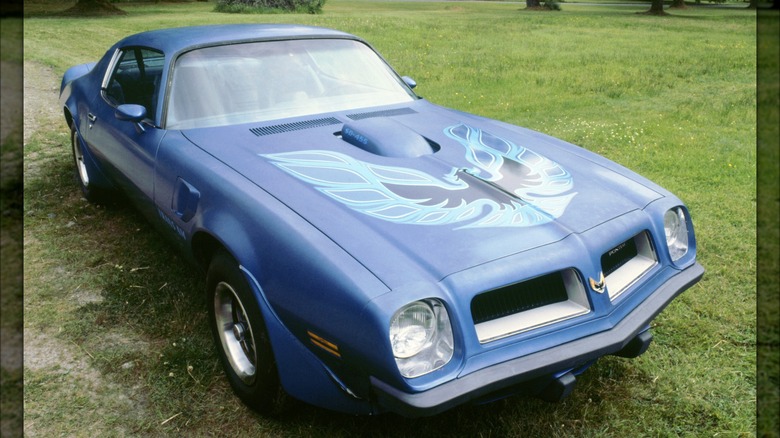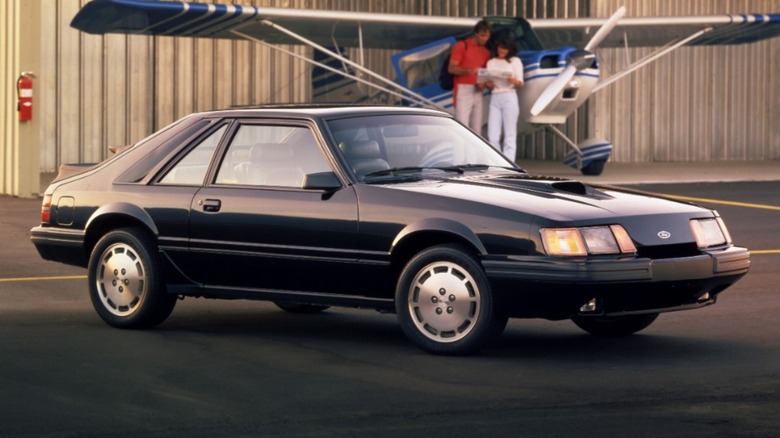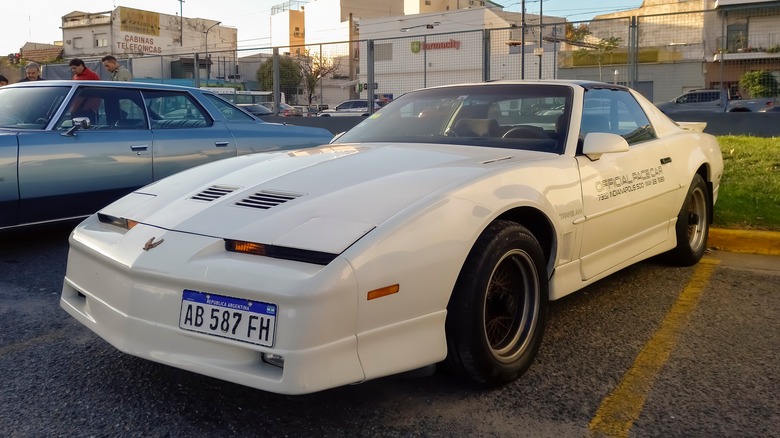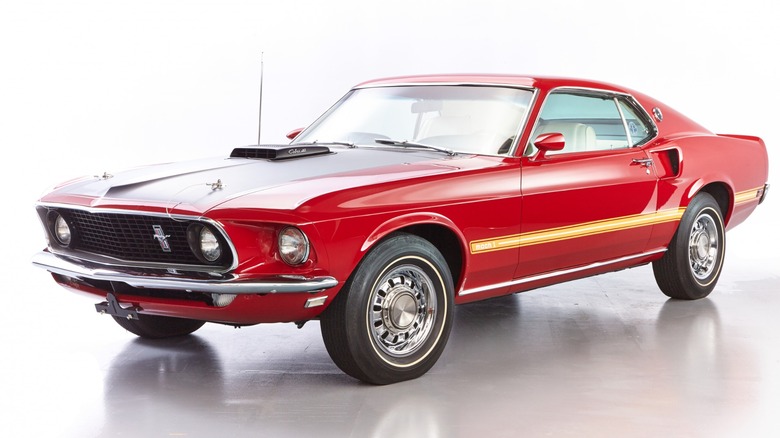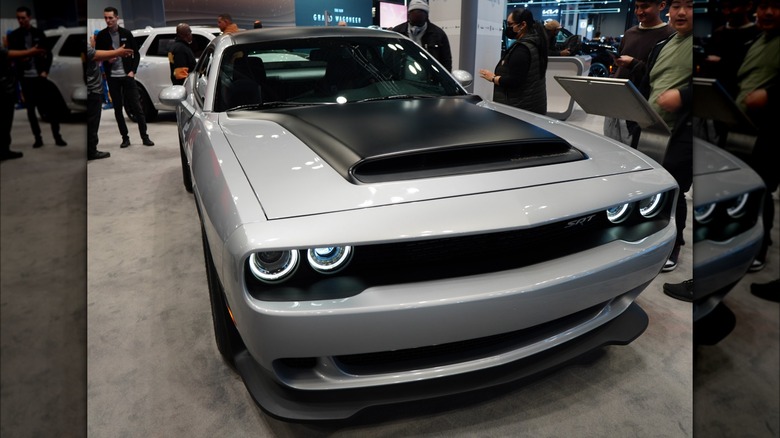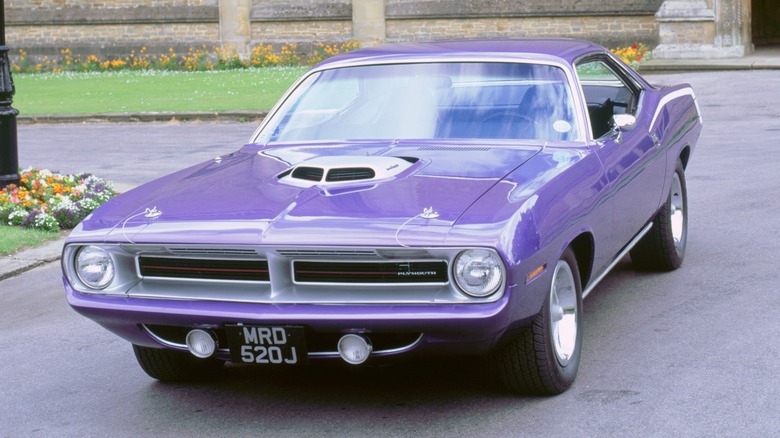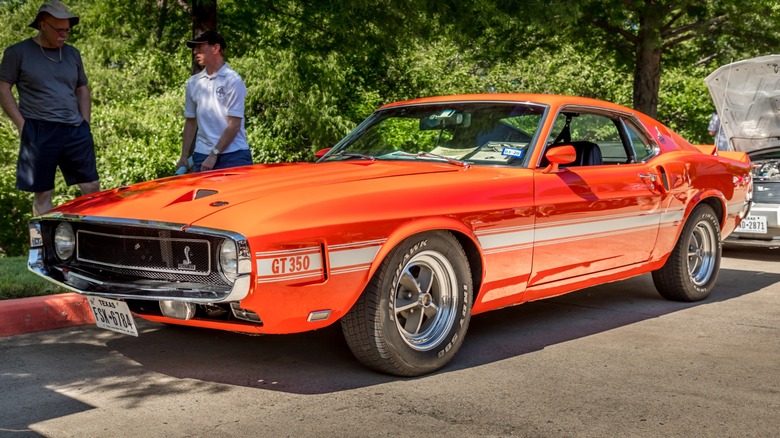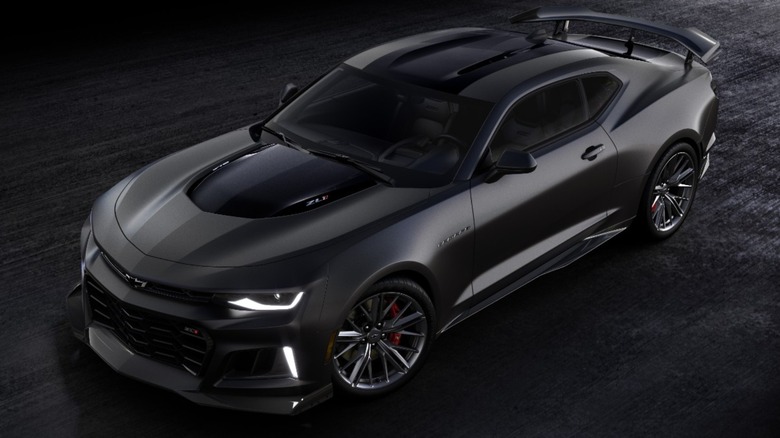11 Of The Coolest American Pony Cars Ever Built
A plan hatched by Ford executive Lee Iacocca to deliver a fun and sporty car at an affordable price is what eventually led to the debut of its Mustang, released as a 1964 ½ year model. It turned out to be just what people wanted, as demand quickly exceeded expectations and the Mustang sold more than 400,000 units — far more than the 150,000 expected. With the incredible popularity of the Mustang, other automakers responded with similar models and the pony car officially became a thing.
While most pony cars can also be classified as muscle cars, the reverse is not necessarily true. Most importantly, a pony car must be small and lightweight. At one time, they were also affordable, but that aspect has changed a bit with more recent models. Some of the favorite models that fit the description include the iconic Ford Mustang as well as the Chevrolet Camaro, Dodge Challenger, Mercury Cougar, Plymouth Barracuda, and AMC Javelin.
European carmakers have made cars with similar qualities, but the pony car seems to be a purely American phenomenon. Some Australian models easily fit the mold and Hyundai even produced a car literally called Pony, but it was far from being a pony car, and the others rarely share the category moniker. This leaves the American auto industry as the prevailing producer of pony cars — here are the 11 coolest examples.
2025 Ford Mustang GTD
While gas-powered sports cars may not be long for this world, Ford has plans to saddle up a few trick ponies before that day comes. Perhaps the coolest example with details available as of the time of writing includes an uber-exclusive Mustang GTD model.
Ford's intention with this car is to build a Mustang that is competitive with anything coming from Europe on all parameters. This means it will be a car with extravagant styling matched by its outrageous power output and finished with a luxury interior trimmed in the finest materials. While it will continue to be a front-engine design, everything about the car will be made to push the boundaries of the chassis in a way that few cars can challenge.
With aerodynamic components grafted onto the body with an abundance of air vents and deflectors to keep components cool while increasing downforce to a maximum, this car is built for speed. A supercharged 5.2-liter V8 producing 800+ horsepower –- output is not yet confirmed –- will make this a horse that is hard to break. The price tag is expected to exceed $300,000, so it will be an extremely exclusive product built in highly limited numbers.
1981 Chevrolet Yenko Turbo Z
By 1980, a new paradigm in auto manufacturing had befallen the industry, leading to precipitously dropping horsepower ratings as a result of much-needed emissions regulations. While the clean air was well and good, performance cars no longer lived up to the name, including pony cars. The 1980 Camaro Z/28 came with an output of a paltry 165 horsepower. However, one upstart Chevrolet dealer who had made a name outfitting Corvairs and Camaros in the '60s with extra power put his touch on a 1981 Camaro called the Yenko Turbo Z.
Starting with a standard Camaro Z/28 in white with an all-black interior, Yenko obtained a kit from Turbo International for installation on the Z/28's LM-1 350 V8. It used a blow-through design that forced air into the carburetor to increase power, with a water-injection system added to control knock. The engine was otherwise just as it came from the factory, but with these modifications car could clear a quarter-mile in 14.51 seconds with a horsepower in the range of 240 to 250. While paltry by today's standards, factory-built Camaros did not reach that level until the end of the decade.
The Yenko Turbo Z is certainly a cool pony car. Sadly, only 19 were made, which also makes it an extraordinarily rare pony car.
2024 Chevrolet Yenko/SC Camaro
Although Don Yenko, who pioneered the Yenko Stinger Corvair and the legendary Yenko Camaros of the late '60s, sold his dealership in 1982 and died while flying a Cessna aircraft shortly afterward, his legacy lives on. Modern Yenko cars are modified by Specialty Vehicle Engineering, a company that has long worked closely with GM in creating special high-performance models sold new through dealerships, much like Shelby and Roush have done with Ford. One of its latest creations is the absolutely bonkers 2024 Chevrolet Yenko/SC Camaro.
The Yenko/SC Camaro begins with a Camaro SS with the optional 1LE track package. SVE then supercharges either a 7.0-liter or 6.8-liter V8 with up to 1,500 horsepower. To handle this much power, H-beam steel rods or forged pro series I-beam rods are installed along with upgraded valvetrains. The 1LE package is mostly left untouched, although it already provides owners with magnetic ride control, an electronic limited-slip differential, a heavy-duty cooling system with dual outboard radiators, and additional coolers for both the transmission and differential.
To finish the exterior, custom graphics are applied to the enlarged carbon-fiber hood with an enlarged air scoop. Pricing runs up to $129,995 for the top-level car, and only 200 in all are planned for production. 2024 will be the last year for the Camaro, and the Yenkos will be a nice send-off for a historical pony car.
1973 Pontiac Trans Am Super Duty
By 1973, the Clean Air Act had been fully implemented, forcing automakers to severely curtail performance and add emissions controls that further hindered power output. Still, one holdout was unwilling to go out without kicking and screaming — Pontiac.
The big block muscle car era had largely come to a close by 1973, with all of the big three paring down their high-output engines across the board. Apparently, however, engineers at Pontiac wanted to keep it up and held on with the 1974 Pontiac Tran Am Super Duty, featuring the 455 big block V8 that gave Pontiac muscle cars their muscle. Pontiac installed a new EGR system on these cars with a time-delay solenoid that made it operate throughout the duration of the testing and then shut down, allowing for full power.
Of course, the EPA caught on to the engineering trick and forced Pontiac to correct it. Despite this setback, the Trans Am Super Duty continued production through the 1974 model year, although true big block pony cars would not return until the 2010s. Engineering shenanigans aside, the Trans Am SD-455 is a gorgeous car with slick lines. Horsepower from the factory is around 300 with gobs of torque, which is still pretty good even compared to modern cars. They are the last of a breed of pony car and exude coolness and class as few cars can.
1987 Ford Mustang SVO
When the regulation of automakers in the 1970s led to a decline in power output, it forced engineers to build cars differently than they ever had before, concentrating on efficiency over raw power. In the 1980s, turbos found their way into more models than ever, often with surprising results. Ford's Special Vehicle Operations (SVO) turned those results into a pony car gem, the Mustang SVO.
At first glance, most people would have no idea the SVO was anything but just another Mustang. However, while a few exterior treatments provide subtle but clear indicators that it is not a typical Mustang, what makes it so special and unique is the 2.3-liter four-cylinder engine. Third-gen Mustangs were offered from the jump with a 2.3-liter OHC 4-cylinder engine — the same one that debuted in the Pinto in 1974.
Thanks to a new turbocharger with an intercooler, the SVO 4-cylinder initially provided up to 175 horsepower in an era when Corvettes barely broke 200. Power would rise to 205, matching that of a 5.0-liter Mustang GT. The SVO lacked a front grille but included an offset hood scoop feeding the intercooler and a cool louver-style spoiler on the rear decklid. The SVO was a low-volume car with incredible potential and power matching cars of the day with engines twice the size. As such a unique car for the day, these are destined to be cool and valuable collector cars for the foreseeable future.
1989 Pontiac Trans Am Official Pace Car
Turbos continued to proliferate in unorthodox arrangements under the hoods of 1980s pony cars. GM's Buick Motor Division proved to be prolific with its turbocharging exercises in the surprise hot rod Buick Grand National. Folks at Pontiac must have liked what they saw as they borrowed the design of the turbocharged 3.8-liter Buick V6 as the basis for its 1989 Trans Am Official Pace Car.
Pace Car models were popular special editions for many years that brought prestige to a brand. Though Pontiac had previously built a Turbo Trans Am, it was a dud, but with the proven Grand National engine, this pony car was a proper bulldogger. With improved cylinder heads, the Pace Car engine was rated at 245 horsepower, equivalent to a contemporary Corvette with nearly two more liters of displacement. However, when put to the test on a dyno, results showed power to break 300 horsepower, revealing a bit of clever marketing deception likely meant to preserve the Corvette's king-of-the-mountain status.
Inside, the Pace Car was among the most luxurious and classy pony cars available in its era, with leather multi-adjustment seats, high-output premium audio with steering wheel controls, custom wheels, and the WS6 performance handling package. While the Official Pace Car graphics are a bit tacky, the rest of the car is among the best of its day. With only 1,555 made, this is one to keep in your paddock.
1969 Ford Boss 429 Mustang
If you name a car Boss, you better be ready to prove it. Fortunately, Ford and lead designer Larry Shinoda did exactly that with the 1969 Boss 429 Mustang. While 1969 also saw Ford bring us the Boss 302, an incredible specimen of Trans Am racing, the Boss 429 is a different breed altogether. As a pony car, the Mustang is built to be a small and lightweight sports car with ample power for good performance. Big block engines add a lot of weight, but they also provide a large increase in power, so the trade-off can be worth it. For the Boss 429, it definitely was.
Though available to the public, the Boss 429 was built from the start as a homologation special in sufficient quantity to qualify the model for NASCAR racing. Ford needed something powerful and light to put up against the Chrysler 426 Hemi cars. To do this, Ford contracted with Kar Kraft Engineering, builder of the original GT40, to modify a stock Mach 1 428 Cobra Jet to accept a huge 429 V8 with custom heads with hemispherical combustion chambers. The 429 was so big that major modifications to the engine bay were required and it still left only slivers of open space in the engine bay. The results were incredible.
The bespoke build process pushed the cost up so much that Ford lost money on each car sold. Regardless, the Boss 429 won 11 straight races, garnering huge street cred for Ford and positive publicity.
2023 Dodge Challenger SRT Demon 170
Back in the day, the Chrysler 426 Hemi ruled the streets and the track as one of the most powerful engines on the market. It has since become legendary and highly valued as a component of classic muscle cars. However, Dodge has more recently delivered what is quickly becoming its own legend in the 2023 Dodge Challenger SRT Demon 170, drawing on the heritage and engineering of the classic 426 Hemi.
The road to the Demon 170 was paved with the 707 horsepower Hellcat in 2015 followed by the 800 horsepower Demon in 2018. As Dodge closed out the final production of the Challenger for good, it gave us 1,025 horsepower from its modern supercharged 6.2-liter Hemi V8. Some of what makes this possible are heavy-duty suspension components, wide tires, and a rock-solid 8-speed automatic. Furthermore, the supercharger air is cooled with an air-to-liquid intercooler.
This is power once unthinkable for a street-legal automobile, and it remains questionable how sane the choice to build it really was. Regardless, for the sheer terror of its power output, the Demon 170 is among the coolest pony cars ever built.
1971 Plymouth Hemi 'Cuda
The Plymouth counterpart to the wildly successful Dodge Challenger was the Barracuda. Though they were introduced simultaneously and share a platform, they are not identical cars, as the Barracuda is nearly five inches shorter. They are further differentiated by cosmetic differences — but a choice of powerful Hemi engines was available for both models.
Plymouth introduced the Barracuda as the base model and dubbed its sporty performance-oriented model simply the 'Cuda, of which the most desirable model was the Hemicuda. Buyers could also choose the 'Cuda with a Magnum 440 V8 with a trio of 2-barrel carburetors for maximum performance. Although the Hemi is the smaller engine, it provides up to 425 horsepower compared to the 385 of the V8.
While Plymouth had historically been Chrysler's budget entry-level brand, buyers were in no way short-changed on a 'Cuda. With clean and graceful lines and an aggressive stance, it remains a stand-out among pony cars, particularly with some of the 25 bold colors originally available, such as Sunfire Yellow, Lime Green, or Vitamin C. These old ponies have always been cool, but some have become cooler than others over time. A 1971 Hemicuda convertible sold for $4.8 million in 2021, setting a record for classic muscle cars.
1969 Ford Mustang Shelby GT350
Carroll Shelby struck a fruitful partnership with Ford Motor Company lasting through 1969, although it would later be rekindled in the new millennium to produce high-performance models for the road and track. His Shelby Mustangs are legendary and although there are several different models, the total quantity built in the early years remains limited. Furthermore, most Shelby models receive a few cosmetic upgrades, and none are so radically changed as the 1969 Ford Mustang Shelby GT350.
For the 1969 model year, Shelby created a different kind of performance car. The Shelby GT350 of that year was meant to be an upscale version with luxury trim and premium appointments to offer a nicer pony car. The original GT350 of 1965 was bare and brash, while the later model was built for a premium upscale grand touring car buyer. Therefore, the '69 model received imitation teak wood dash panels, door accents, wood-trimmed steering wheel, and high-back bucket seats. A 351 V8 powered it through a four-speed or automatic transmission, pushing 290 horsepower to the rear wheels.
The most distinctive features were the unique wrap-around front bumper with a custom grille and a fiberglass hood with a trio of functional NACA ducts channeling air to the engine. Most distinctive of all was the convertible models revealing a rollbar with the top retracted. All this made for one of the coolest stallions Ford has ever built.
2024 Chevrolet Camaro ZL1
For the final year of production of the Chevrolet Camaro, the top offering continues to be the powerful ZL1 model. With its 6.2-liter V8, the ZL1 offers 650 horsepower thanks to its intercooled supercharger. The current car dates back to 2012, when the ZL1 package was released as an homage to the original 1969 model, which was ordered through the Chevrolet's Central Office Production Order (COPO) system using engine code ZL1, a 427 racing engine developed for the Can-Am racing series.
The ZL1 became a racing legend and later a sought-after Camaro. The latest ZL1 comes standard with its outrageously powerful V8 but is offered with an optional 1LE Extreme Track Performance package. Equipped with this, the ZL1 is a genuine steed, ready to take you for a ride. However, with the 1LE option, handling through the curves on a track should be smooth and steady, but regular commuting almost certainly will contribute to lower back pain. Just the same, that is likely not a concern for anyone ordering this car.
The best part about owning a ZL1 is that you have a car that provides you with the performance and handling that can keep up with most supercars at a fraction of the price, as it costs just around $75,000. While it is expensive to most folks, that's a performance bargain. Furthermore, with the discontinuation of the model, the 2024 ZL1 is taking it out on a high note.
